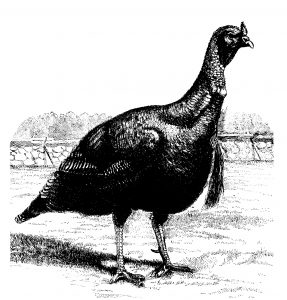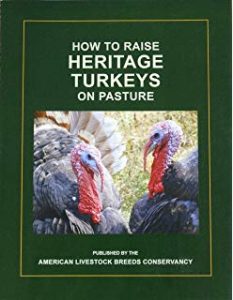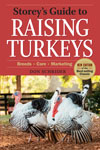
Breed Facts
Status:
Watch
Use:
Meat, Exhibition
Egg Color:
Pale cream to medium brown with spotting
Egg Size:
Large
Weight:
Male Young – 16 lbs. Mature – 20-22 lbs.
Female Young – 10 lbs. Mature – 12 lbs.
Temperament:
Highly dependent on socialization selection by breeder; some select for aggressive, others docile. Toms may pick on other species if kept together.
Characteristics:
Good flyers; excellent foragers; curious and like people.
ROYAL PALM TURKEY
The Royal Palm is a strikingly attractive and small-sized turkey variety. The first birds in America to display the Palm color pattern appeared in the 1920s from a mixed flock of Black, Bronze, Narragansett, and wild turkeys on Enoch Carson’s farm in Lake Worth, Florida. Since then, selection has stabilized the color pattern and conformation. An anonymous breeder wrote to Feathered World magazine in 1931, “Turkeys of this type of coloration do crop up by chance where different color varieties are crossed…but it takes years to perfect their markings.”
The Royal Palm was recognized in the American Poultry Association Standard of Perfection in 1971. The coloration is similar to a European variety called the Pied, Cröllwitzer Ronquieres, or Black-laced White, known since the 1700s.
Royal Palm turkeys are white with a sharply contrasting, metallic black edging on the feathers. The saddle is black, which provides a distinct contrast against the white base color of body plumage. The tail is pure white, with each feather having a band of black and an edge of white. The covert feathers are white with a band of black, and the wing feathers are white with a narrow edge of black. The breast is white with the exposed portion of each feather ending in a band of black to form a contrast of black and white similar to the scales of a fish. The turkeys have red to bluish-white heads, a light horn beak, light brown eyes, red to bluish-white throat and wattles, and deep pink shanks and toes. The beard is black.
Standard weights for Royal Palm toms are 16 lbs. for young and 20-22 lbs. for mature toms. Young hens average only 10 lbs, and 12 lbs. for mature hens, making this a good breed for those with smaller properties. Hens lay under 20 pale cream-to-medium-brown spotted eggs in the spring. Hens are broody and can be good mothers.
These thrifty turkeys are excellent and active foragers, and good flyers. It is best to keep them confined with adequate fencing to keep them from wandering too far. If they are not given shelter, they will roost in trees. Toms are usually non-aggressive with people, especially if handled frequently as poults. They are curious and like to be with people as adults.
Although Royal Palms may lack the commercial potential of other standard-bred turkey varieties due to its smaller size, it is an important variety for at-home meat production or where its ability to control insect pests would be of value.
Did you know:
The Dominique chicken is America’s oldest chicken breed and was widely raised on farms in the 1800s. Did your grandparents raise “Dominikkers”? Learn more about this beautiful but threatened breed at Dominique chicken – The Livestock Conservancy

Breed Facts
Status:
Watch
Use:
Meat, Exhibition
Egg Color:
Pale cream to medium brown with spotting
Egg Size:
Large
Market Weight:
10 – 16 lbs
Temperament:
Highly dependent on selection by breeder, Some select for aggressive, others docile
You may be interested in…




